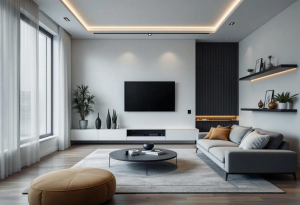Mid-Century Modern. Just the name brings to mind those cool, clean lines, open spaces, and a certain optimism that defined an era. But it’s way more than just a trip down memory lane. It’s a whole design philosophy that’s making a serious comeback. As an architect, I’m seeing this renewed interest firsthand, and it’s pretty awesome to watch how it’s being re-imagined for today.
The Roots of Cool: Understanding Mid-Century Modern
Think back to the post-World War II boom. Mid-Century Modern (MCM) architecture popped up as a solution to the need for homes that were efficient and affordable, but also fresh and new. The key? Clean lines, a minimalist vibe, and everything built with a purpose. New materials and technologies were embraced. We’re talking about visionaries like Richard Neutra, Charles and Ray Eames, and Eero Saarinen – the folks who really shaped the movement. They put a huge emphasis on natural light, blending homes with nature, and creating a feeling of openness, even if the space wasn’t huge.
Modernism Week 2025: Proof the Style is Alive and Kicking
Events like Modernism Week? They’re not just for show. They prove that MCM is here to stay. I was lucky enough to attend earlier this year, and the energy in Palm Springs was unreal. Architectural tours showed off perfectly preserved homes, and discussions were held about where MCM design is headed. It was clear that this style isn’t just some relic; it’s alive, influential, and shaping contemporary architecture right now. The number of people who showed up, and their passion? It all points to a real resurgence.

Sustainability: MCM Gets a Green Makeover
One of the coolest things about this revival? How sustainability is being woven into the design. Back in the day, MCM architects were already thinking about the environment, using things like passive solar design and natural materials. Now, architects are taking it even further, using eco-friendly materials, energy-efficient systems, and finding ways to conserve water. We’re seeing MCM homes built with reclaimed wood, solar panels that blend right into the roof, and rainwater systems for the garden. It’s all about respecting the original vibe while being kind to the planet.
For example, you’ll often find sustainably sourced timber, bamboo floors, and countertops made from recycled glass. The goal is to create spaces that aren’t just pretty and practical, but also responsible and resource-smart. This ties in perfectly with the growing demand for green building practices and homes that are both stylish and eco-conscious.
Curves Ahead: Softening the Edges
While those clean lines are still a big deal, we’re seeing MCM get a little softer around the edges with the return of curved furniture and organic shapes. Think about rounded sofas, arched doorways, and those classic kidney-shaped coffee tables. It adds a touch of fun and warmth to the sometimes-stark MCM look, making living spaces feel more welcoming and comfortable. I’ve been playing with curved elements in my own designs, and they create a sense of flow and interest, especially in open floor plans.
It’s not just furniture, either. Architects are incorporating curved walls and ceilings to create movement and energy. It’s a step away from those strict geometric shapes, adding sophistication and elegance, and making MCM feel more modern and less rigid.
Bringing the Outside In: The Power of Biophilic Design
The OG MCM architects knew that connecting with nature was key. Huge windows, sliding glass doors, and patios were all about blurring the lines between indoors and out. Now, this idea is being amplified with biophilic design, which focuses on bringing natural elements into our buildings. We’re talking plants, natural light, and materials that create spaces that are beautiful and good for our well-being.
I’ve had clients specifically ask for living walls, indoor gardens, and water features in their MCM-inspired homes. The idea is to create a calming, restorative environment that helps you relax and de-stress. This focus on biophilic design is a natural fit for MCM, which already emphasizes natural light and a connection to the outdoors.
Retrofuturism: A Blast From the Future
Another cool trend is how retrofuturism is influencing modern MCM designs. Retrofuturism mixes old-school aesthetics with futuristic technology and concepts. In MCM, this means adding things like space-age lighting, geometric patterns inspired by atomic structures, and those bold, 1960s colors. It’s playful, imaginative, and adds a touch of whimsy to the MCM vibe.
Architects are experimenting with new materials and technologies to create retrofuturistic MCM spaces. Think 3D-printed furniture, smart home tech that blends seamlessly into the design, and lighting that mimics the sun’s natural rhythms. The result? A unique, captivating mix of past and future.
Making MCM Work For You
So, how do you bring Mid-Century Modern into your own projects? Here are a few tips to get you started:
- Keep it Simple: Focus on clean lines, minimal details, and clutter-free spaces.
- Go Natural: Use wood, stone, and natural fabrics like linen and wool.
- Let There Be Light: Maximize natural light with big windows and skylights.
- Color Pop: Don’t be afraid of bold colors, but use them wisely. Think pops of orange, avocado green, or mustard yellow.
- Mix It Up: Combine vintage MCM finds with contemporary pieces to create a space that’s all your own.
The MCM revival isn’t just a trend; it’s proof that good design lasts. By understanding the core principles of MCM and applying them to your work, you can create spaces that are timeless, modern, functional, and beautiful all at the same time.


